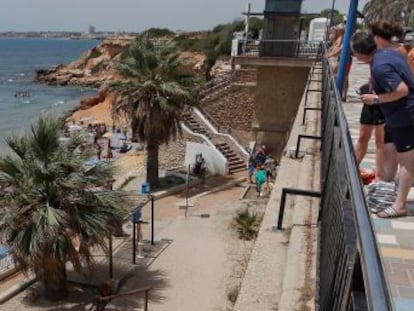Rise of selfie deaths leads experts to talk about a public health problem
A new global study shows one fatality a week on average this year, mostly involving young people attempting a risky photo to gain more followers on social media

A yellow fever jab and some malaria tablets used to be the classic precautions for tourists traveling to certain locations. But in the age of the smartphone, avoiding taking selfies in death-defying, if spectacular, locations can now be added to the list.
A study by the Spanish iO Foundation, which specializes in tropical diseases, has revealed that between January 2008 and July 2021 at least 379 people – one out of every 13 days on average – have been killed in this way. It is a growing trend, one that after a brief hiatus due to the coronavirus pandemic has resurfaced during the first seven months of this year, during which time there have been 31 fatal accidents – one per week – despite the raft of travel restrictions still in place worldwide.
“It is a growing problem that, because of the dimensions it has taken on, can now be considered a public health issue. The study has helped us to put it into context and that is the first step toward taking preventive action,” says Manuel Linares Rufo, president of the iO Foundation and lead researcher on the report, the largest of its kind carried out to date. Tourists accounted for 141 deaths during the period under investigation, compared with 238 fatalities among local residents. This shows that the tendency to take risks is much higher among the former, taking into account that only a tiny fraction of the world’s population is traveling at any given moment.
The countries where the highest number of reported fatalities are India (100), the United States (39) and Russia (33), which head a list of more than 50 nations. Spain, with 15 deaths, is sixth alongside Australia. The authors of the report, which will be published shortly in the Journal of Travel Medicine, have also compiled data on the 10 most lethal places on Earth for selfie hunters, although this has not been included in the final text. These are, without being ordered in terms of the number of fatalities: Niagara Falls (USA/Canada), Glen Canyon (USA), Charco del Burro (Colombia), Penha Beach (Brazil), Mlango Falls (Kenya), the Ural Mountains (Russia), the Taj Mahal and Doodhpathri Valley (India), the island of Nusa Lembongan (Indonesia) and the Langkawi archipelago (Malaysia).
Despite these numbers, the study only collates the most visible part of the problem due to its limitations. The data was compiled using an epidemiological intelligence tool known as the Heimdllr Project, which combs through all the published information available such as news stories and official statements, in six widely used languages: English, Spanish, French, German, Portuguese and Italian. This method therefore does not record cases that do not make it into the media and those that have only been published in other languages. The study also does not include the large number of serious accidents that did not result in death.
Accidents in places such as waterfalls, cliffs and rooftops were by far the most common cause of a sought-after selfie ending in tragedy, with 216 fatalities recorded. These were followed by transportation-related accidents (123), drowning (66), firearms and electrocutions (24 each) and injuries caused by wild animals (17). By age group, deaths were most frequent among the 19-and-under range (41% of the total) and those in the their 20s (37%) – the average age of fatalities in the study is 24.4 – while the ratio of males to females was three to two.

Media stories about this issue have had a significant repercussion over the past few years, particularly when the victim is well-known on social media. One of the most recent cases involved an influencer named Sophia Cheung, 32, who was famous for posting pictures taken in extremely dangerous places. Cheung died in July after slipping and falling from a waterfall in Hong Kong. The last known case in Spain is even more recent and, as such, not included in the iO study. It took place on September 14 in the Mediterranean resort city of Benidorm, where a Ukrainian tourist fell from a height of 30 meters from the castle viewpoint in the old part of town. Other recent incidents in Spain include a 24-year-old Norwegian who fell from a ninth-floor balcony in Marbella in May, a 28-year-old woman who fell from a Barcelona rooftop in November 2020, and a 14-year-old who fell from skylight in Madrid last March.
“The idea of doing the study came about when we saw the notable impact that news of these deaths was having and the lack of perception of the problem in scientific literature, and in the recommendations give by travel medicine,” says Linares Rufo. “To a certain extent, the study was born from the pandemic. Due to the coronavirus many tools have been developed that we can now use to study phenomena like this and help to tackle them. One option is to identify the most dangerous places and issue warnings to people visiting them, something which should also involve cellphone manufacturers, app programmers and [social media] administrators. At the local level, training programs should be organized,” the researcher adds.
The city council of Benidorm has already started to take measures. “It is something that has become more visible after what happened in September, but we were already working on it,” says a local government spokesperson. “The local police include patrols of the most sensitive places in their daily security briefings and are even using drones to keep an eye on the most-visited spots. Now we want to look at how to introduce this issue into the talks that police officers give in schools to get across the importance of avoiding this sort of behavior.” In India, the growing number of fatalities among selfie hunters has led to some areas being declared “selfie-free zones.”
Liliana Arroyo, a sociology PhD and author of a book on the subject, points out that selfies, like social networks, “have become another form of relationship and social communication that, in the vast majority of cases is a healthy way of expressing oneself that can be very creative, as well as a way to share interests and concerns.”
To understand how this innocuous way of relating to other people can lead to risky behavior, Arroyo lays out certain conditioning factors. “Social networks reward the most extreme content, because they work on dynamics where this kind of content allows them to attract more attention. The prize for taking a very risky selfie is social standing and this gives you a rush of adrenalin for every ‘like’ that you receive. This in turn leads some people who need this social validation to look for new ways to test the limits and seek further reward, and that is where people’s capacity to weigh if the reward is worth the risk or not lies.”
Psychiatrist Enrique García Bernardo places the increase in selfie deaths within a global phenomenon in which social networks have played an important part. “These images have become a quick way to obtain immediate, easy and superficial recognition. What counts most are followers and ‘likes,’ not the achievement itself. It is a social mechanism for reassertion that has become more widespread in recent years. Taking this into account, some people are more inclined to engage in risky behavior. According to the temperament-related categories defined by [American psychiatrist] Robert Cloninger, it is these people who tend to seek new thrills and whose behavior is less conditioned toward the avoidance of harm.”
Taking the most dangerous selfie is not the only risk that some people are willing to assume. Gigi Wu, a Taiwanese climber, gained fame for her hobby of scaling mountains in a bikini and taking pictures on often snow-covered summits in a series of striking poses. She died in 2019 when she fell into a ravine, although it wasn’t the fall that killed her. She suffered injuries to both legs and was unable to move, but she did manage to call the emergency services. By the time rescuers found her though, she had died of hypothermia because of a lack of proper cold-weather clothing.
Tu suscripción se está usando en otro dispositivo
¿Quieres añadir otro usuario a tu suscripción?
Si continúas leyendo en este dispositivo, no se podrá leer en el otro.
FlechaTu suscripción se está usando en otro dispositivo y solo puedes acceder a EL PAÍS desde un dispositivo a la vez.
Si quieres compartir tu cuenta, cambia tu suscripción a la modalidad Premium, así podrás añadir otro usuario. Cada uno accederá con su propia cuenta de email, lo que os permitirá personalizar vuestra experiencia en EL PAÍS.
¿Tienes una suscripción de empresa? Accede aquí para contratar más cuentas.
En el caso de no saber quién está usando tu cuenta, te recomendamos cambiar tu contraseña aquí.
Si decides continuar compartiendo tu cuenta, este mensaje se mostrará en tu dispositivo y en el de la otra persona que está usando tu cuenta de forma indefinida, afectando a tu experiencia de lectura. Puedes consultar aquí los términos y condiciones de la suscripción digital.
More information
Archived In
Últimas noticias
The new victims of the Republican war on Obamacare: Millions hit by soaring health insurance premiums
A country divided on migrant rights: Some US states expand protections while others restrict them
Venezuela authorizes the release of another 87 political prisoners
There is as much life left to discover on planet Earth as that which is already known
Most viewed
- David King, chemist: ‘There are scientists studying how to cool the planet; nobody should stop these experiments from happening’
- Reinhard Genzel, Nobel laureate in physics: ‘One-minute videos will never give you the truth’
- Oona Chaplin: ‘I told James Cameron that I was living in a treehouse and starting a permaculture project with a friend’
- Sinaloa Cartel war is taking its toll on Los Chapitos
- The Interoceanic Train, the Mexican alternative to the Panama Canal











































